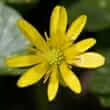Background
- Lesser celandine (Ranunculus ficaria) is a perennial herbaceous meadow plant in the buttercup family that is found in Europe, Asia, Canada, and the northeastern and northwestern parts of the United States, where it is considered an invasive species. Lesser celandine is not to be confused with greater celandine (Chelidonium majus), a member of the Papaveraceae family.
- According to herbal textbooks and tradition, lesser celandine has astringent properties and has been used to treat inflammatory conditions. Lesser celandine was once known as "pilewort" and has been used to treat hemorrhoids. It is also known as "scurvywort," because its leaves have been used as a source of vitamin C. Scurvy is a condition that results from vitamin C deficiency.
- There is currently a lack of high-quality clinical trials available investigating lesser celandine for any medical condition.
- It has been reported that all parts of the lesser celandine plant are poisonous.
References
- Cooley NM, Holmes MG, Attridge TH. Growth and stomatal responses of temperate meadow species to enhanced levels of UV-A and UV-B+A radiation in the natural environment. J Photochem Photobiol B 2000;57(2-3):179-85. View Abstract
- Strahl S, Ehret V, Dahm HH, et al. [Necrotizing hepatitis after taking herbal remedies]. Dtsch Med Wochenschr 1998;123(47):1410-4. View Abstract







